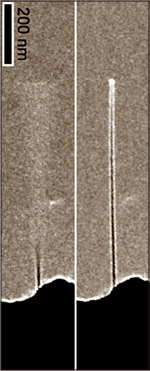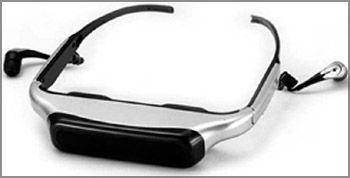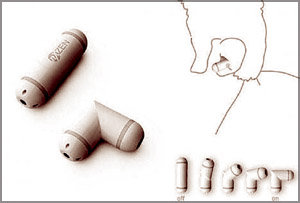A 'Nanoradio' is in sight.
 With
the rapid perfection of technology, miniaturization is apparent. It
seems as if the radio couldn't escape this extreme miniaturization, and
researchers have created the world's tiniest radio just out of a carbon
nanotube, escalating the capabilities of nanotechnology to a higher
rung. With
the rapid perfection of technology, miniaturization is apparent. It
seems as if the radio couldn't escape this extreme miniaturization, and
researchers have created the world's tiniest radio just out of a carbon
nanotube, escalating the capabilities of nanotechnology to a higher
rung.
They have found out that a nanotube, placed between two electrodes,
would function as all the major electrical components in a radio,
including the tuner and amplifier. It can tune in to a radio signal and
play the audio through an external speaker.
The practical importance of such a tiny radio would seem hazy. But,
this has shown interesting prospects of being used in biological and
environmental sensors.
Researchers are now developing microelectromechanical (MEMS) sensors
to measure blood sugar levels or cancer markers in the body. Replacing
the stamp sized RFID tag, a nanotube radio could be packaged with the
MEMS-based sensor and injected directly into the bloodstream.
Once in the body, the radio could provide wireless communication
between the tiny biological sensors and an external monitor. To do that,
however, the nanotube radio would have to work as a transmitter.
Although it is only configured as a receiver at the moment, the same
physics are expected to work as a transmitter.
Carbon nanotubes have been previously used to make electronic
components such as diodes, transistors, and rectifiers because of their
unique electrical properties. This has turned out to become a revelation
that all of this could be built into the same nanotube.
The nanotube radio works differently than a conventional radio does.
Conventional radios have four main functional parts: antenna, tuner,
amplifier, and demodulator.
Radio waves falling on a radio antenna create electric currents at
different frequencies and when someone selects a radio station, and the
tuner filters out just one of the frequencies. Thereafter, transistors
amplify the signal, while a demodulator separates the data or other
audio that has been encoded on a carrier electromagnetic wave.
The part where this differs from the conventional sense is that
instead of picking up electromagnetic waves electrically, it picks them
up mechanically. This happens because of the nanotube's natural
resonance frequency.
As soon as it encounters radio waves that match the frequency, the
nanotube starts vibrating in step with the waves, effectively tuning in
only to that radio signal. The nanotube's vibrations change the field
emission current, and the mechanical vibrations are converted into an
electrical signal.
An external battery powers the field emission current and amplifies
the radio signal. The field emission naturally allows current to flow
only in one direction, just like the diodes and rectifiers used in
demodulators. Therefore, the nanotube also acts as a demodulator and
detects the music encoded onto the carrier wave.
To tune to a different radio station, the researchers change the
resonance frequency of the nanotube, by simply changing the voltage
applied across the electrodes, which is analogous to tuning a guitar.
This way, researchers can cover the entire FM radio band with the
same nanotube, and let's look forward to what this new 'nanoradio' has
to offer the world in the days to come by.
****
Trendy gadgets of the week
A new solution to
dental patients
 Going
to a dentist is a nightmare for most of the patients. They prefer an
anesthesia doze when the treatment is on, to prevent a painful
experience. Dutch-based RelaxView has release the RelaxView 5.0 Dental
Pack, a light-weight video eyewear, to distract dental attention of the
patients without side effects. Going
to a dentist is a nightmare for most of the patients. They prefer an
anesthesia doze when the treatment is on, to prevent a painful
experience. Dutch-based RelaxView has release the RelaxView 5.0 Dental
Pack, a light-weight video eyewear, to distract dental attention of the
patients without side effects.
The extremely portable and comfortable device includes a head mounted
display and has the capacity to showcase a cinema screen of 1.4 meters
on a distance of 3 meters that offers a resolution of 640x480 and full
color viewing angle of 32 degrees.
Dr. Rob Roef, a dentist in Nijmegen, the Netherlands has stated, "It
is all about focus. Patients that, only occasionally see, hear, taste
and smell the things that happen in dentistry tend to become very
sensitive even for the more simple procedures.
The pain that people experience should not be minimized. Some people
are so frightened that they require anesthetic treatment, or they simply
don't seek necessary treatment until it is too late. Facilitating and
helping to get the patients' focus away from pain to pleasure pays off
for both the patient and the dentist."
***
A
new Bluetooth headset concept
 A
new concept has arisen in the field of Bluetooth headsets. This, which
is known as Pillete, is so tiny that it is almost invisible to the
untrained eye when you are wearing it. A
new concept has arisen in the field of Bluetooth headsets. This, which
is known as Pillete, is so tiny that it is almost invisible to the
untrained eye when you are wearing it.
So you don't have to worry anymore about looking like Robocop when
walking down the street with it, but you have to consider the
possibility of people starting to think you have lost your marbles and
you are talking to yourself.
The downside is the fact that people have different sized ears and
the device might be too small and slip out or too big and not fit.
However, once they figure out a way to make the Pillete adjustable, this
design will be the future of all headsets.
Aravinda Dassanayake |
